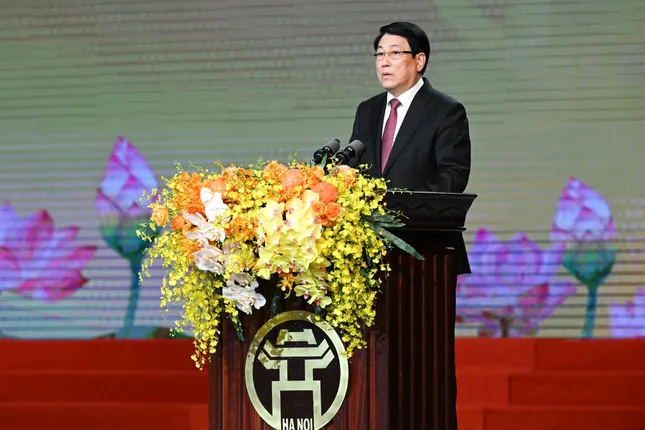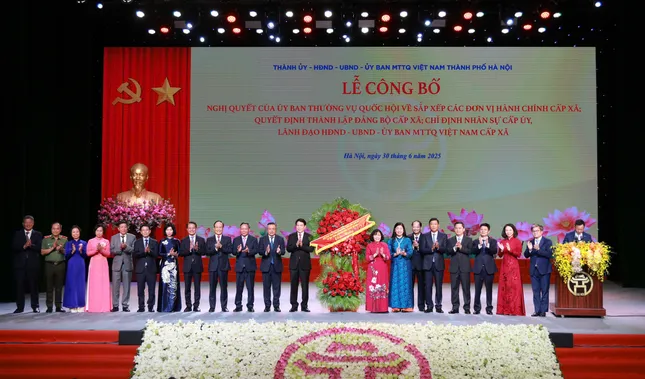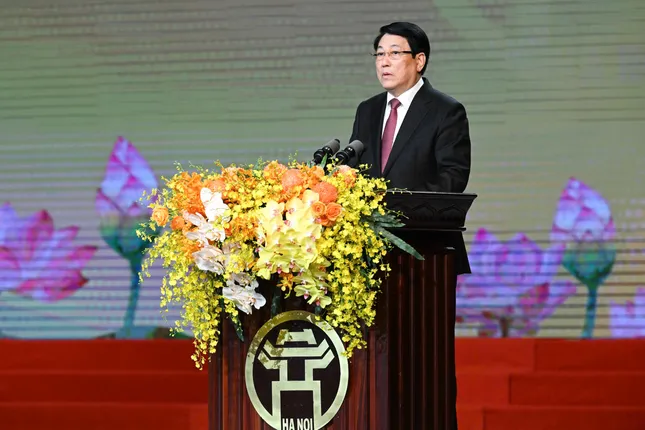On the morning of June 30, Hanoi held a ceremony to announce the National Assembly’s resolution and the city’s decision on the merger of administrative units and the establishment of new Party and Vietnam Fatherland Front committees in the newly formed wards and communes. The event was held at the Vietnam-Soviet Friendship Labor Culture Palace and was attended by 126 newly established wards and communes of the capital city.
The ceremony was honored by the presence of Mr. Luong Cuong, the President of Vietnam. Also in attendance were Le Khanh Hai, Head of the Presidential Office; Hoang Dang Quang, Vice Chairman of the Central Organization Committee; and Hoang Cong Thuy, Vice Chairman of the Vietnam Fatherfront Central Committee.
In his speech, President Luong Cuong expressed his emotion in attending the ceremony to announce the decisions made by the Central Committee and Hanoi on the rearrangement of communal-level administrative units. He highlighted that this event marks a very special milestone for both Hanoi and the entire country, as from July 1, 2025, the local government apparatus across the nation will officially transition from a three-tier system, which has been in place for nearly 80 years since the country’s establishment on September 2, 1945, to a two-tier local government system.
President Luong Cuong commended the rearrangement of the administrative apparatus and units as a significant and long-term strategic move by the Party and the State, demonstrating their determination to build an administrative system that is streamlined, efficient, and effective in serving the people. He emphasized that this event is not merely about adjusting administrative boundaries but also carries immense political and organizational significance for the country’s sustainable development.

President Luong Cuong delivers a speech at the ceremony.
The President particularly highlighted the significance of this administrative rearrangement for Hanoi, a city with a thousand years of cultural and heroic history, and its crucial role as the country’s political and administrative center, the heart of Vietnam. He emphasized that Hanoi is also a major hub for culture, education, training, science, technology, and international integration.
“This administrative rearrangement in Hanoi holds immense significance, aiming to meet the needs of urban development, cultural and historical preservation, administrative reform, and more efficient utilization of the capital’s space and resources,” President Luong Cuong stressed.
The President also commended the Hanoi Party Committee for their proactive and creative approach in reorganizing the administrative apparatus, reducing the number of communal-level units from 526 to 126.
He noted that this administrative rearrangement has received the support and high appreciation of the capital’s officials, party members, and people, opening up new opportunities for Hanoi to serve as the growth engine not only for the city but also for the Red River Delta region, the Northern Key Economic Region, and the entire country.
Based on the important policies and legal frameworks issued by the Party and the State for the two-tier local government system, President Luong Cuong proposed that the Hanoi Party Committee and authorities continue to concretize and effectively implement these policies. He particularly emphasized the importance of adhering to the Central Committee’s Instruction No. 45 on the organization of party congresses at all levels towards the 14th National Party Congress, as well as resolutions of the Politburo on the “four-pillar” groups and the resolution on the direction and tasks for Hanoi’s development until 2030, with a vision towards 2045, and the 2024 Law on the Capital City.

President Luong Cuong presents flowers to congratulate the Hanoi Party Committee, People’s Council, People’s Committee, and Vietnam Fatherland Front Committee.
















